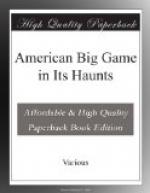No moose, of course, are found in the plains country of Assiniboia, Saskatchewan, and Alberta; but east in Keewatin, and to the north in Athabaska, northern British Columbia, and northwest into Alaska we have an unbroken range, in which moose are scattered everywhere. They are increasing wherever their ancient foe, the Indian, is dying off, and where white hunters do not pursue too persistently. In this entire region, from the Ottawa in the east to the Kenai Peninsula in the far west, moose are retiring toward the north before the advance of civilization, and are everywhere occupying new country.
[Illustration: ALASKA MOOSE HEAD SHOWING UNUSUAL DEVELOPMENT OF ANTLERS—KENAI PENINSULA. Kindness American Museum of Natural History, New York.]
Wary and keen, and with great muscular strength and hardihood, the moose is pitting his acute senses against the encroaching rifleman in the struggle for survival, and it is fair to believe that this superb member of the deer family will continue to be an inhabitant of the forest long after most other members of the group have disappeared.
The moose of Maine and the Maritime Provinces occupy a relatively small area, surrounded on all sides by settlements, which prevent the animals from leaving the country when civilization encroaches. In this district their habits have been greatly modified. They do not show the same fear of the sound of rifle, of the smell of fire, or even of the scent of human footsteps, as in the wilder portions of the country. In consequence of this change of habit, it is difficult for a hunter, whose experience is limited to Maine or the Maritime Provinces, to appreciate how very shy and wary a moose can be.
In the upper Ottawa country, when they first began to be hunted by sportsmen, the writer remembers landing from his canoe on the bank of a small stream, and walking around a marsh a few acres in extent to look at the moose tracks. Fresh signs, made that morning, were everywhere in evidence, and it had apparently been a favorite resort all summer. Snow fell that night and remained continuously on the ground for two weeks, when the writer again passed by this swamp and found that during the interval it had not been visited by a single moose. The moccasin tracks had been scented, and the moose had left the neighborhood. A moose with a nose as sensitive as this would find existence unendurable in New Brunswick or Maine.
I have already referred to the relative size of the antlers of the moose from different localities, and called attention to the inferiority of the heads from the extreme east. Large heads have, however, come from this section, and even now one hears of several heads being taken annually in New Brunswick running to five feet and a little over in spread. The test of the value of a moose head is the width of its antlers between the extreme points. The antlers of a young individual show but few points, but these




